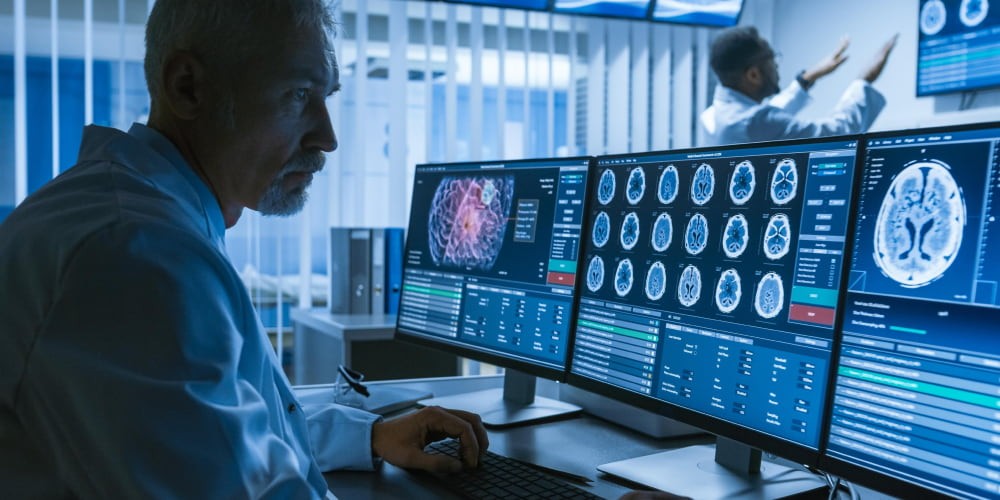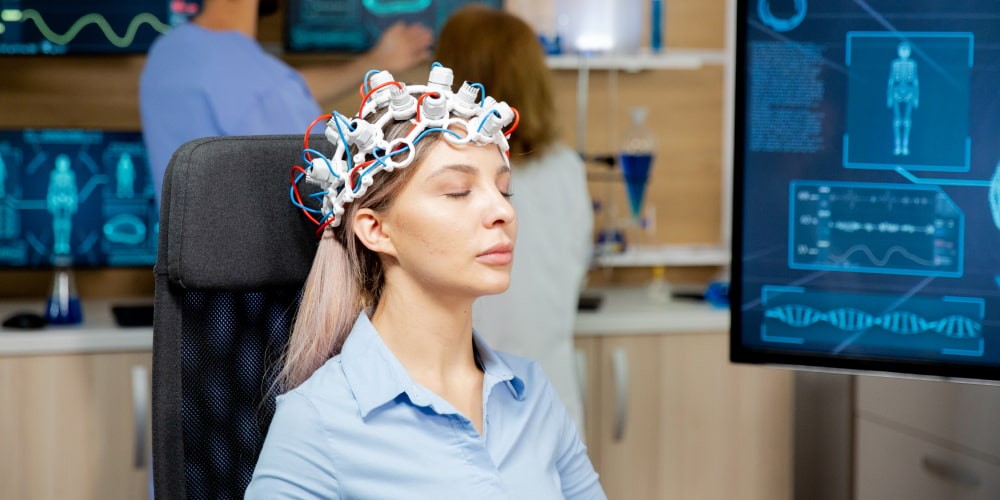EEG plays a crucial role in the diagnosis and management of convulsions. EEG is a non-invasive technique. It measures and records the electrical activity of the brain. It captures the synchronized electrical potentials generated by the brain’s neurons. And it provides valuable insights into the underlying neural activity.
In the context of convulsions, the EEG test serves as a powerful tool for diagnosing seizures. It distinguishes them from other conditions and monitors the effectiveness of treatments. The recordings can reveal distinctive patterns associated with convulsion activity, such as:
- Sharp waves.
- Spikes.
- Rhythmic discharges.
These patterns help neurologists and epileptologists make accurate diagnoses. And they can classify different types of fits.
This comprehensive understanding of fit activity assists in tailoring individualized treatment plans. In our article, we will tell you all about EEG for epilepsy.
Explaining Epilepsy
Convulsions is a neurological disorder that affects millions of people worldwide. Recurrent and unprovoked fits characterize it. They are sudden and abnormal electrical disturbances in the brain. Fits can manifest in various forms. They’re brief episodes of altered consciousness or muscle cramps and severe convulsions.
The underlying causes of epilepsy can be diverse and EEG helps find them. It includes genetic factors, brain injuries, infections, or developmental abnormalities. Illness can occur at any age. But it most commonly begins in childhood or during adolescence. The impact extends beyond physical fits. Individuals may also experience cognitive, emotional, and social challenges.
Understanding involves unraveling the complexities of its mechanisms. Medical professionals rely on diagnostic tests. They are EEG for epilepsy and brain imaging. It’s to diagnose and classify types accurately. Treatment options vary depending on the individual and may include:
- Medication.
- Dietary modifications.
- Surgery.
- Neuromodulation techniques.
Common Causes and Risk Factors
Most widespread causes and risk factors are:
- Genetic predisposition.
- Brain injuries from accidents or trauma.
- Infections, such as meningitis or encephalitis.
- Developmental abnormalities in the brain.
- Stroke.
- Brain tumors.
- Certain metabolic disorders.
Risk factors for seizures that need EEG test for illness :
- Family history of condition.
- Age – illness can develop at any age, but it’s more common in young children and older adults.
- Sex – certain types of condition may be more prevalent in males or females.
- Head injuries, especially those involving loss of consciousness.
- Brain infections or diseases.
- Prenatal factors, such as maternal drug use or infections during pregnancy.
- Stroke or other cardiovascular diseases.
- Drug or alcohol abuse.
- Sleep deprivation.
- Exposure to environmental toxins.
Different Types of Seizures
Types of seizures that EEG test for illness detects:
- Generalized Fits:
- Absence fits (previously called petit mal fits).
- Tonic-clonic fits (previously called grand mal fits).
- Myoclonic fits.
- Atonic fits.
- Tonic fits.
2. Focal Fits (Partial Fits):
- Focal onset aware fits.
- Focal onset impaired awareness fits.
Characteristics:
- Fits can vary in duration, intensity, and symptoms.
- Symptoms may include loss of consciousness, muscle jerking or convulsions, sensory changes, emotional alterations, and cognitive impairments.
Understanding the common causes and risk factors is crucial for identifying potential triggers. And it helps in developing appropriate management strategies.
The Role of EEG in Epilepsy Diagnosis
EEG is particularly useful in diagnosing epilepsy. It’s because it can capture the distinctive electrical patterns that occur during fits. These patterns help differentiate fits from other conditions. The patterns are spikes, sharp waves, or rhythmic discharges.
The information obtained from EEG tests for seizures recordings assists neurologists and epileptologists in:
- Classifying the type of illness.
- Determining the location and spread of fit activity.
- Evaluating the effectiveness of treatments.
Continuous EEG monitoring, including long-term ambulatory and video EEG, allows for the detection and documentation of elusive fit events that may occur intermittently.
By providing objective and quantitative data on brain activity, EEG test for seizures:
- Enhances the accuracy of diagnosis.
- Helps guide treatment decisions.
- Contributes to a better understanding of the underlying mechanisms of the disorder.
It’s an indispensable tool in the comprehensive evaluation and management of individuals.
How EEG Measures Brain Activity?
It’s done by placing electrodes on the scalp. They detect and record the electrical signals generated by the brain’s neurons. These electrodes are connected to an amplifier. It amplifies and processes the signals for further analysis.
The electrical activity recorded by EEG for epilepsy represents the summation of the electrical potentials. The synchronized firing of thousands or millions of brain neurons produces them. These electrical signals are categorized into different frequency bands. They’re delta, theta, alpha, beta, and gamma waves. Each associated with specific brain states and functions.
The recordings are often displayed as waveforms called an EEG trace. They provide information about brain activity patterns. It includes the presence of abnormal electrical discharges associated with fits in illness.
EEG Test for Seizures: Procedure and Interpretation
Here are some considerations:
- Preparation. Before the EEG test, the patient cleans the scalp. It’s to ensure optimal electrode contact. They need to wash their hair. The patient is typically asked to avoid caffeine and certain medications. They may affect brain activity.
- Electrode Placement. Electrodes for EEG for epilepsy are usually placed on specific locations on the patient’s scalp. They’re positioned according to the international 10-20 system. It allows for consistent electrode placement across individuals.
- Recording. Once the electrodes are in place, the patient must relax and stay still during the recording. The EEG for epilepsy machine amplifies and records the electrical signals over a specific period. It typically ranges from 20 minutes to several hours.
- Seizure Provocation. In some cases, specific techniques may be employed to provoke fits during the EEG. This can involve hyperventilation (deep and rapid breathing), photic stimulation (flashing lights), or sleep deprivation. These triggers can help reveal abnormal brain activity associated with fits.
- Interpretation. A qualified healthcare professional usually analyzes the recorded data. It’s often a neurologist or epileptologist. They examine the EEG trace for specific patterns. They are spikes, sharp waves, or rhythmic discharges, which may state convulsion activity. The location, duration, and frequency of patterns are used in the diagnosis.
- Correlation with Clinical Information. The EEG findings are interpreted in conjunction with the patient’s clinical history, symptoms, and video recordings captured during the EEG test for seizures. This comprehensive approach helps in accurate diagnosis, fits classification, and treatment planning.
EEG Test Preparation
Here are key considerations for EEG for epilepsy test preparation:
- Medication and Diet. Follow instructions provided by the healthcare provider of any medications. Patients may need to stop using them before the test temporarily. Certain medications may affect brain activity and could interfere with the EEG results. In some cases, specific dietary restrictions may be also advised.
- Hair Care. The scalp must be clean and free of oils, gels, or hairsprays. Those may interfere with electrode placement. Depending on the length and condition of the hair, you may need to wash it the night before or on the day of the EEG epilepsy diagnosis. Avoid using hair products on the day of the test.
- Sleep Schedule. It may be necessary to have reduced or modified sleep patterns before the EEG test. Alterations in sleep schedules can help find certain types of abnormal brain activity. It may be useful in the diagnostic process.
- Clothing. Wear comfortable clothing that allows easy access to the scalp for electrode placement. Avoid wearing hats, scarves, or any headgear that may interfere with electrode attachment.
- Communication with the Healthcare Provider. Inform the healthcare provider about any concerns, medications, or medical conditions. Those may be relevant to the EEG test. Discuss any specific instructions or questions to ensure appropriate preparation.
Conclusion
In conclusion, EEG is a vital tool for diagnosis and managing epilepsy. It measures and records the electrical activity of the brain. And it provides valuable insights into the patterns and abnormalities associated with fits.
It helps:
- Differentiate fits from other conditions.
- In classifying fit types.
- In determining the location and spread of fit activity.
EEG test for seizures plays a pivotal role in unraveling the mysteries of illness. It provides crucial information for medical professionals. And it ultimately improves the lives of those affected by condition.
FAQs:
- What is the duration of an EEG test for seizures?
The duration of an EEG test for seizures can vary depending on the specific requirements of the test. It typically lasts anywhere from 20 minutes to a few hours. Extended EEG monitoring may be necessary in some cases, which can last for several days or even weeks.
- Can an EEG diagnose epilepsy?
EEG is a valuable tool in diagnosing and managing epilepsy. But it alone cannot definitively diagnose epilepsy. But it provides crucial information about the electrical activity of the brain. It helps healthcare professionals in making an accurate diagnosis.
- Is EEG a painful procedure?
EEG is a non-invasive procedure and is generally not painful. The electrodes are usually placed on the scalp. It may cause a mild sensation or temporary discomfort. But the procedure itself is painless. And the patient can remain comfortable during the test.












Please, leave your review
Write a comment: